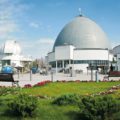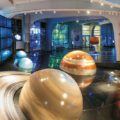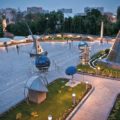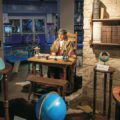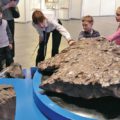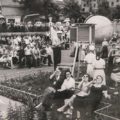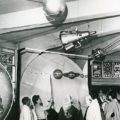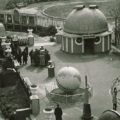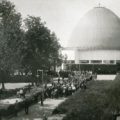At the Moscow Planetarium, you can see stars at any time of the day, launch a black hole with your own two hands, and watch the entire creation of the universe in just a few minutes.
Let there be a Planetarium
Russia dreamt of space exploration since the beginning of the 20th century, when scientists started gazing into the mysterious starry sky more and more often. After the revolution, the space theme became so hot that the construction of a planetarium that would become the centre for the nationwide popularisation of space and astronomy gained particular relevance.
In 1927, a commission was set up to build a planetarium in Moscow. By that time, 12 planetariums had already been opened across the world, and the one in Moscow became the 13th.
By the spring of 1928, the trade mission of the USSR in Berlin agreed with the Carl Zeiss company on the delivery of a Planetarium projection device and engaged Dickerhoff firm to supply a fabric dome that would serve as a screen to demonstrate the starry sky.
Architects Mikhail Barsh and Mikhail Sinyavsky were commissioned to design the Moscow Planetarium. They presented a project in Constructivist style that aimed to inform the environment by creating structures with clear-cut external forms made of simple stereometric elements and assembled on a reinforced concrete frame.
The foundation stone of the Moscow Planetarium was laid on September 23, 1928, on the day of the autumnal equinox. Just over a year later, on November 5, 1929, the Moscow Planetarium was opened to the public.
The Planetarium opens its doors
The Planetarium started with a small series of lectures. However, by 1939 the number of lectures had reached 40, and in 1934, the dome-screen of the Moscow Planetarium showed stars twinkling, clouds floating, comets streaking across the sky, aurora oscillating, as well as meteoric showers, solar eclipses, dawns and sunrise. None of this existed in any planetarium in the world until the end of the 1950s.
That same year, the first astronomy club was established at the Moscow Planetarium, which later transformed into a school of astronomy. Many graduates of the planetarium’s astronomy clubs are now the pride and the elite of the Russian science.
Between 1934 and 1938, the Moscow Planetarium was home to the Group for the Study of Jet Propulsion (GIRD) and the Stratospheric Committee. It also hosted engineering and design courses, and it was here that the method of studying the stratosphere dynamics using smoke bombs was first developed and implemented. The first liquid-fuelled rocket was designed and built at the Planetarium, as well as the first Soviet two-stage rocket. The group of rocket scientists of the Moscow Planetarium later became the famous KB-7 design bureau that conducted research and development to improve rocket engines, the main element of spaceships, and worked on fuel improvement and missile stability in flight. The specialists of KB-7 designed 12 variants of liquid-propellant ballistic missiles. R-03, R-03/s, R-06/g and ANIR-5 missiles were manufactured in small batches and then flight-tested.
The Planetarium during WWII
In the wartime, the Moscow Planetarium provided practical assistance to the soldiers and commanders of the Soviet Army by organizing special military-focused lectures for scouts and military pilots. In addition to in-house lectures, it held field masterclasses on astronomy. The Moscow Planetarium was functioning throughout the wartime, with a short break of only two months.
Post-war years
In 1947, the Planetarium opened the Astronomical Venue that was, and still is, the largest in Moscow. The Astronomical Venue takes its roots in the tradition of ancient star retreats and features, among other things, an extensive collection of sundials created from sketches by researchers at the Moscow Planetarium.
The Moscow Planetarium gradually became Russia’s largest centre for popularisation of natural science. Thousands of lectures were given here each year. The Planetarium provided great scientific and methodological contribution in the creation of all other planetariums of the country.
Navigators of arctic and long-distance aviation were trained at the Planetarium. In 1960–1975, it held astronavigation classes attended by all future cosmonauts. Alexey Leonov, who made world’s first spacewalk, once said: «The road to Baikonur began at the Moscow Planetarium».
In the 1970s, the Planetarium attracts enormous numbers of visitors, up to a million people per year. In 1977, the old Planetarium device was replaced by a new one with an automated control system. In 1987, the Planetarium hosted the 9th International Congress of Planetarium Directors.
A unique 300mm Carl Zeiss refractor telescope was installed at the Grand Observatory of the Planetarium in 1989. The observatory can be visited by anyone, and the device is still the largest public telescope in Moscow.
The second birth of the Planetarium
Between 1994 and 2004, the Moscow Planetarium underwent not just major renovation, but an actual reconstruction. To bring the building to its former glory, it was decided to raise it by 6 metres using powerful hydraulic jacks. Thanks to that, the Planetarium’s silhouette that was once hiding behind modern buildings returned to the Moscow skyline. During the reconstruction, the total area was expanded from 3,000 to 13,000 square meters, and new spaces were created. The renovated building was equipped with state-of-the-art devices including the latest generation Universarium M9 fibre optic starry sky projector, a fulldome projection system with a stereo projector, and a 4D cinema and a Small Star Hall.
On June 12, 2011, on Russia Day, the Moscow Planetarium opened its doors. The brand new planetarium quickly gained popularity and was visited by about one million people during the first year after its reopening.
The Planetarium. Present days
The Moscow Planetarium is currently one of the top-20 most visited museums and scientific & educational venues in Moscow.
Every visitor can find something to their liking on the four floors of the Planetarium. In the first and second hall of the Uranium Museum guests can learn about the history of astronomy and stages of space exploration, and in Lunarium interactive museum one can launch the process of black hole formation with their own hands, while at the Large Star Hall people can admire unforgettable view of the starry sky shown by Universarium M9 projector.
The planetarium has its own studio for the production of full-dome films and star programmes, and also offers interactive astronomy classes in the Fascinating Science Theatre for young kids, Star Lessons for school children and popular science sessions in the Family Lecture Hall for children and their parents.
Starlit romance, scientific interest, dreams of cosmic adventures — you can find all this at the Moscow Planetarium, and a lot more!
Mikhail Vakhneev

